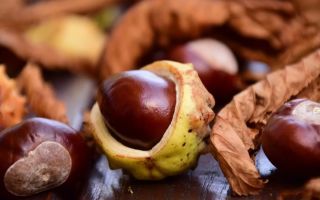Content
- 1 What does the chestnut look like and where does it grow?
- 2 How does edible chestnut differ from horse
- 3 The chemical composition and calorie content of chestnut
- 4 Why are edible chestnuts useful?
- 5 The use of chestnuts in traditional medicine
- 6 How chestnuts are used in cosmetology
- 7 Edible chestnut in cooking
- 8 Harm of chestnuts and contraindications
- 9 Is chestnuts possible for pregnant and lactating
- 10 How to choose and store chestnuts
- 11 Conclusion
In ancient Rome, it was customary to grind chestnuts. Delicious pies and bread were baked from flour. Over time, the value of chestnut flour has decreased, the edible fruits of chestnut have become a kind of delicacy additive, they are made an ingredient in gourmet cuisine. The benefits and harms of edible chestnut depend on the type of use and processing before cooking.
What does the chestnut look like and where does it grow?
Chestnut trees are deciduous trees that can grow up to 50 m in height, the bark of the slender trunk has a brown tint. The leaves are lanceolate and are recognized by the small jagged edges. Nuts begin to ripen in October or early November, and after fully ripening they fall off and split open.
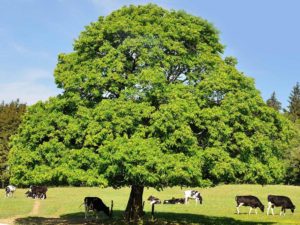
The territories in which chestnuts are most often found are the countries of Europe, Asia Minor, and the southern regions of Russia. Chestnuts can coexist with fir, beech or hornbeam.
How does edible chestnut differ from horse
Chestnut trees belong to the beech genus. Among the known varieties, beech and oak are distinguished. It is a small family that is classified according to various characteristics.
Horse chestnut belongs to the horse chestnut family. Edible chestnut and horse chestnut are similar only in name. Equine fruits are not eaten. They are suitable for pet food. The nuts of both representatives are outwardly similar. They are placed in plyus, which burst when ripe. Trees are distinguished by the structure of the leaves, the quality of flowering:
- horse chestnut blooms profusely, inflorescences are collected in the likeness of a vertical candle;
- edible inflorescences resemble elongated earrings.
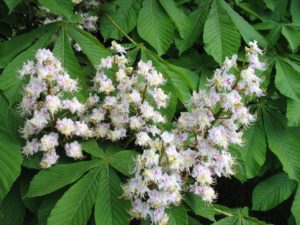
The chemical composition and calorie content of chestnut
The benefits of edible chestnut nuts depend on the chemical composition of the edible portion. It contains:
- ash compounds;
- starch, glucose, sucrose;
- saponins, coumarins, bioflavonoids;
- B vitamins;
- carotene, vitamin K, vitamin C;
- tannins;
- organic acids (citric, lactic, malic).
The group of minerals is represented by compounds of calcium, iron, zinc, barium.
Raw fruits contain:
- 1.63 g protein;
- 25.44 g fat;
- 17 g of carbohydrates.
This composition has an energy value of 196 kcal.
Among the vitamins, the content of vitamin C, PP and vitamin B 1 is increased. In the group of minerals, potassium takes precedence, followed by phosphorus, followed by magnesium.
The calorie content of the edible chestnut fruit depends on the method of preparation and the amount of consumption. In European cuisine, it is customary to cook plushi by baking or roasting them. The amount of elements in the chemical composition of edible chestnut is directly dependent on the ripening conditions. Dry periods promote the formation of nuts, which have less water, increased fiber and sugar.
Why are edible chestnuts useful?
The edible fruits of the chestnut are used for cooking in the north and east of Europe, the people of other European countries also appreciate the benefits they bring.
A trendy trend is gaining momentum, which is practicing the inclusion of edible chestnuts in healthy diets.
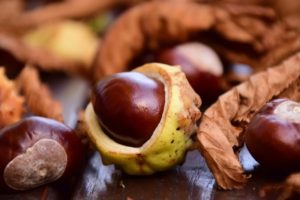
Due to their chemical composition, breadfruit nuts have a number of beneficial properties that affect the human body:
- the content of dietary fiber helps to improve digestion;
- pectins tend to reduce the acidity of gastric juice (this is useful for people suffering from pancreatic diseases);
- amino acids, flavonoids, minerals and vitamins endow with the ability to have a bactericidal effect (these mechanisms contribute to the suppression of the activity of fungal bacteria, reduce the risks of developing viruses);
- vitamins, unsaturated fatty acids have a beneficial effect on intestinal peristalsis;
- the combination of minerals and ascorbic acid makes the product useful for people with diseases that affect the state of the cerebral vessels;
- eating nuts reduces the risk of developing atherosclerotic plaques, improves blood flow.
The beneficial properties of the tree are also used for the preparation of external agents: decoction lotions are suitable for healing ulcers, relieving edema with thrombophlebitis or varicose veins.
The content of various microelements makes the product useful as a tonic and tonic.
The increased vitamin C content increases the health benefits of eating edible chestnuts. They are recommended for colds and inflammatory conditions of the upper respiratory tract.
For men
The increased content of fiber and protein in edible seeds, as well as the presence of pectin substances, make them useful for men.
Saponins affect the synthesis of male hormones, which contributes to the normalization of the reproductive system.
Edible nuts are useful for men over 40 as a safe remedy to improve potency. Tinctures of tree fruits are used in the complex therapy of prostate adenoma.
For women
The beneficial properties of edible nuts for women are:
- relief of conditions during menstrual cycles;
- strengthening blood vessels and preventing the development of varicose veins;
- normalization of blood flow;
- reducing the risk of developing cancer.
For seniors
The medicinal properties of edible chestnut are useful for the elderly, their use is justified in cases where it is necessary:
- prevent the formation of atherosclerotic plaques and vasoconstriction in the brain;
- saturate the brain with oxygen.
These mechanisms of action are the prevention of strokes and heart attacks. Similar beneficial effects can be achieved through the systematic use of chestnuts. The benefits are increased when the chestnuts are selected and cooked well.
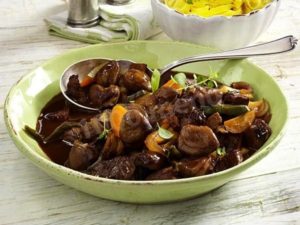
For children
In Europe, the chestnut is often referred to as the "energy bar". Despite the many beneficial properties of edible chestnut, it has contraindications when used in baby food. It is not recommended to give it to children if they are under 5 - 6 years old.
The digestive system of children is not fully formed, so the fruits can become heavy, poorly digestible food for her. To eliminate the risk of harm to the child's body, you should consult with a pediatrician about eating nuts.
One of the conditions for use is correct preparation and gradual introduction into the children's diet.
Slimming
Features of chestnut fruits are used when planning dietary programs. The high content of carbohydrates endows them with the ability to quickly saturate the body, replenish the reserves of proteins, carbohydrates and nutrients.
The use of chestnuts in traditional medicine
The properties of edible chestnut are widely used in traditional medicine recipes: it is used for the preparation of tinctures, external remedies, added to food, and independent dishes are prepared on its basis.
For colds, edema and inflammation of the larynx, decoctions of fruits are used, which tend to increase the discharge of sputum, relieve spasms that provoke a cough.
Broth and baked fruits are used as a means:
- regulation of strengthening of capillaries;
- control of the level of bad cholesterol;
- activation of exchange processes.
How chestnuts are used in cosmetology
The female part of the population of Russia and residents of European countries use edible nuts in home cosmetology.

The benefits of using edible chestnut as a topical cosmetic are hard to miss. It is recommended to add its pharmacy extracts or flour to the funds.
Extracts of edible fruits are added to creams and face masks, hair shampoos, hand balms, bath foams, and anti-cellulite products.
The properties of edible chestnut relieve inflammation and skin irritation, improve color, cleanse, rejuvenate are used in face masks.
To relieve inflammation, reduce the fragility of capillary vessels and normalize the sebaceous glands, a chestnut-honey mask is prepared that will suit all skin types.
Shampoos with healthy edible chestnut in the composition restore the hair structure, make it strong and strong.
With the help of body lotions, you get the effect of enhancing microcirculation in the skin, toning the skin, smoothing, lifting, getting rid of the "orange peel".
Bath foams have a good relaxing and skin-softening properties.
Tannins have properties that are indispensable in cosmetology. Compounds of substances, flavonoids and essential oils in a complex:
- saturate the skin with oxygen;
- contribute to the restoration of the upper layer of the epidermis;
- act as a filler: they fill in expression lines and smooth them out.
Due to the property of edible chestnut to neutralize the harm of exposure to ultraviolet rays, it is added to tanning products.
With the help of wood oil, care for aging and dry skin. And the ability of a foot cream with edible chestnut to relieve puffiness and fatigue is used in the prevention of varicose veins.
Stagnation of blood harms the body, this mechanism provokes the formation of cellulite, reduces the overall skin tone. Peeling from edible chestnut prevents stagnation of blood flow, activates the processes of hematopoiesis.
Edible chestnut in cooking
Properly cooked chestnuts have not only beneficial properties, but also bright taste. The chestnut tree has long been called "bread". This is due to the fact that the powder of ground nuts was used for baking bread. Modern chefs use the nut as an ingredient in salads, soups, and serve as a side dish, which is combined with vegetables. This additive enriches the dish and increases the benefits.
Roasted chestnuts
To roast chestnuts yourself, there are some rules to follow. The peculiarity of nuts is that the plyusa, or the shell that covers the nuts, becomes dense, stretched after ripening. If not cut, it will burst and rebound.
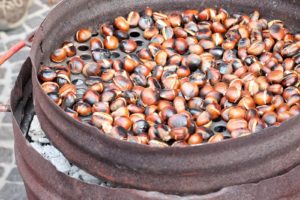
Immediately before frying, the chestnuts are washed, pierced through the shell, or slightly cut. Fry on minimal heat for about 20 minutes, readiness is determined by cracking the cover and the softness of the contents.
After frying, the peel is removed, the pulp is mashed or added to other dishes.
Chestnut soup
Chestnut soup is a French dish that is prepared with a variety of ingredients.The classic recipe uses nuts and broth.
Boiled chestnuts are cleaned, poured into a saucepan with meat broth, boiled for half an hour. At the last stage, vegetables sautéed in butter are added and served with fried bread. Many people prefer to break the contents with a blender and serve them as a puree soup. The classic recipe does not exclude serving with pieces of boiled vegetables and chestnut pulp.
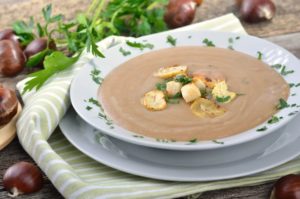
Harm of chestnuts and contraindications
One of the nuances of using chestnut fruits for food can be the wrong choice. Horse chestnut fruits are poisonous and unsuitable for consumption. In some cases, they are confused and try to cook a delicious dish from horse chestnut.
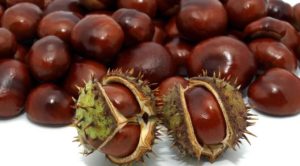
Eating nuts can be harmful to people who have allergic reactions to food. Chestnut fruits are a specific product, therefore they can cause non-standard reactions of the body.
They are not recommended for people with kidney failure. Admission may harm the genitourinary system.
Nuts are also contraindicated for people who suffer from diabetes. The carbohydrate content can be harmful, provoke an exacerbation of diabetic conditions.
Is chestnuts possible for pregnant and lactating
Chestnuts are not recommended for pregnant and lactating mothers: they can harm the development of a possible allergic reaction.
For nursing mothers, the fruit's ability to influence the gastrointestinal tract is not beneficial. This mechanism often provokes bloating, the onset of colic in breastfed babies.
How to choose and store chestnuts
To minimize the risk of harm to the body and maximize the benefits of eating, it is necessary to choose the right chestnuts.
The period when the nuts are fully ripe is from September to February. External signs by which to distinguish edible chestnuts that can benefit:
- hard, smooth shell;
- absence of spots, damage, plaque;
- glossy brown sheen;
- feeling of heaviness;
- rounded shape;
- absence of a green layer between the core and the shell.
Storage is complicated by the fact that the fruits tend to deteriorate quickly. If the storage rules are violated, such nuts can be harmful.
In order to prevent the formation of unhelpful compounds in the composition, they are stored under a temperature regime not exceeding +20 ° C, in a dry, dark place for about 5 days.
Store in the refrigerator for about 2 weeks, wrapped in edible paper to avoid mold. The fruits are also advised to be kept frozen.
Conclusion
The benefits and harms of edible chestnut are issues that don't exist in isolation. When taken in excess, edible chestnuts can be harmful to the body. The correct preparation of a fresh product helps to expand the boundaries of taste, aids in obtaining nutrients and has a positive effect on the functioning of the body's systems.

